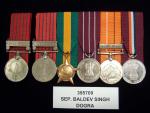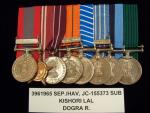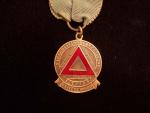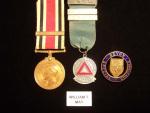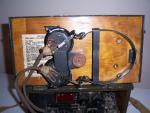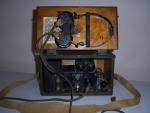-
Posts
6,486 -
Joined
-
Last visited
-
Days Won
10
Content Type
Profiles
Forums
Blogs
Gallery
Events
Store
Everything posted by Brian Wolfe
-
Hi Erik, An interesting poster. Can you provide any further information? You said it was Canadian but what did you mean? I assume it is a propaganda poster printed in Canada as I doubt the German's whould have protrayed themselves in that manner, U-Boat Captains were their heros, after all. With the lack of English on the poster would this indicate it was produced for the French speaking (ie. Quebec) Canadians? Regards Brian
-
Here is another group from the Dogra Regiment that I have resently completed court mounting. This group was awarded to, 395709 SEP.BALDEV SINGH of the Dogra Regiment. His medals are as follows: General Service - Naga Hills clasp. This was a double issue and that is why one was mounted up alone. It would not have been part of the group. Poovri Star Sangram Medal Sainya Seva Medal - Himalaya clasp 25th Independence Anniversary Medal His medals show that he served in a combat zone during the 1971 Indo-Pakistani War in the Eastern Theatre as well as in the Naga Hills, an area between India and the former country of Burma, as well as in the Himalayas. The Sainya Seva Medal is awarded for service in severe climate and conditions.
-
I've been a bit lazy lately and have not been adding any groups to this thread nor to my Member's Gallery. Too busy saving the world I guess...only kidding the world is doomed. I just finished court mounting this group of eight that was awarded to, 3961965 Sep./Hav./JC-155373 Sub Kishori Lal of the Dogra Regiment. I hope you like it. His medals are as follows: Special Service w/ the Sri Lanka clasp Paschimi Star Sangram Medal Sainya Seva w/ the NEFA clasp UCCHH Tungta/ High Altitude Medal Videsh Seva Medal w/ the Sri Lanka clasp 20 Years Long Service Medal 9 Years Long Service Medal This group shows a nice progression through the ranks from Sepoy (Private) to a Subedar (Captain) and service from the Punjab in the North West (Paschimi Star and Sangram Medal) to the North East (NEFA clasp to the Special Service Medal)as well as overseas service in Sri Lanka. Far from a comfortable service as indicated by the High Altitude Medal which is for service in the High Himalays above 9,000 feet and the NEFA clasp to the Sainya Seva Medal which is for construction of roads and air fields in an area south of the Chinese boarder and north of Assam. I hope to be posting more groups within the next few days as well as updating my gallery so stay tuned in and please add some of your own to this thread. Regards Brian
-

My home made dummy with my new gear on it
Brian Wolfe replied to Desertrat's topic in United States of America
Hi Keenan, Very nice bit of kit. It's good to see collectors putting together WWII uniforms as it won't be long before the pieces will be nearly impossible to find. I recall (this is old guy talk) when WW I uniforms were so common that the pants, shirts and jackets were used in place of "work wear" as they were a lot cheaper and lasted longer. The next thing you knew you could hardly find any for sale in the military surplus stores. Thanks for preserving these important atrifacts and also thanks for taking the time to share it with the membership. Regards Brian -
Once in a while there is a Special Constabulary Medal offered either in a group or with related items and these are always nice to add to a collection. Naturally there is often a premium to be paid for such groups and when the items' relationship to one another cannot be substantiated by any official documentation one needs to be careful not to pay too much for the grouping. I've read opinions that if the vendor is known and trusted that this should go a long way to accepting the authentisity of the grouping as being from one individual. I have a bit of a problem with such assumptions and don't invest too much cash in one of these so-called "attributed" groupings. Having said that I did pay a bit of a premium for this grouping as the SC Medal is the King George VI FID:DEF: issue which is quite scarce being only issued from 1949 - 1952. Here is the grouping that is "attributed" to William T. May of the Devon Special Constabulary Service. The bar on the named SC Medal is 1960 which places William May in service starting in the rein of King George VI and still serving during the rein for Queen Elizabeth II. The three bars on the 5 Years Safe Driving Competition Award are 1960 (same as the SC Medal bar), 1961 and 1962. The maker's name on the plane reverse of this medal is, FATTORINI & SONS Ltd., 36 BARR ST., B'HAM. The lapel button is to the Devon Special Constabulary and it is held on to the jacket etc. by a half-moon shaped stud. This stud is marked, J.R.GAUNT, LONDON. I liked the red and the blue enamel on the Driving Medal and the lapel pin and makes a nice little (so far unattributed) grouping.
-
Hello Ed, Nice items and a very informative link. Thanks for adding to my education, so much for not having to use my brain once I grasduated. Regards Brian
-

Some killer photos.....
Brian Wolfe replied to Chris Boonzaier's topic in Great Britain: Research, Documentation & History
Hi Chris, Great photos, I hope you will post more. Regards Brian -

WW1 trio info need
Brian Wolfe replied to Adam C's topic in Great Britain: Orders, Gallantry, Campaign Medals
Hello Adam, Welcome to the forum. Thanks for posting your question. It cleared up something I have often wondered about myself. Hope to hear more from you in future. Regards Brian -
Hello Rohee, Welcome to the GMIC. I hope to hear more from you regarding Bahwalpur Medals as It is an interest of mine as well. Regards Brian
-
That's an interesting photo Chris. I used to own a GEW88, bought it from an antiques dealer who was using it to prop the front door open, and they are heavy enough to shoulder for a regular sized fellow. Pop the bayonet on this and the whole thing becomes almost too awkard to aim. On the other hand I think I would want to be short if I were in the trenches. Tall could be bad depending on the depth of the trench. Regards Brian
-

The Fuller Phone Mk IV
Brian Wolfe replied to Brian Wolfe's topic in Great Britain: Militaria: Badges, Uniforms & Equipment
When used in a situation such as at Headquarters it was common to slide the Fullerphone out of its case and use it in the manner shown below. Note the Morse key to the right of the unit. I hope you enjoyed this post and a look at the amazing Fullerphone. For more check out "Wireless for the Warrior" on the internet. Regards Brian -

The Fuller Phone Mk IV
Brian Wolfe replied to Brian Wolfe's topic in Great Britain: Militaria: Badges, Uniforms & Equipment
Here is a closer view of the headset housed in the lid. The Mk IV in my collection is housed in a wooden box. -
It was mid-1915 and the war was not going well for Brittan's "Contemptible Little Army" and her Allies. Every move on the part of the Allies seemed to be known by the Germans ahead of time and thwarted. Raids were met by either artillery or well prepared troops. Relief troops were met with shouts of "welcome" by the Germans as they took over from exhausted front line soldiers. In one case it is said that the Regimental march was played by the Germans for the Scottish troops newly arrived to the trenches. With trenches only yards apart in some areas this preparedness on the part of the German Army was nothing short of phenomenal. A very efficient espionage organization was suspected by the Allies. An organization that had some how infiltrated their military machine from the highest levels right down to the front line operations. The thoughts of such an organization must have created a great deal of fear and paranoia in the ranks and caused the senior staff to have doubts of any chance to advance until these agents were ferreted out. Just when this problem of espionage seemed to be insurmountable a British civilian who had been interned by the Germans made it back home with the answer to this conundrum. It turned out not to be espionage at all but simply the Germans listening in to signals passed to them through the earth. After some experimentation it was proven that the problem was indeed due to induction of the signals themselves. The Allies had been using an earth return. Part of the problem was solved through the use of metallic circuits, in this case twisted pairs of wires in place of the earth return previously employed, however, listening in continued to be a problem due to tapping into these lines. In October 1915 Captain (later Maj. Gen.) A.C.Fuller invented the Fullerphone which prevented "listening in" through any means, with the exception of the use of another Fullerphone. If security during this period was anything like it was in the Second World War every precaution would have been employed, even at the cost of the operator's life, to prevent a Fullerphone from falling into enemy hands. The Fullerphone was tested extensively in the water filled area of Ypres and found to work very well. This was the answer they were looking for. After the War modifications and improvements were made and in 1939 the Mk IV went into service. This was the most successful model, being easier to use and much more sensitive the the earlier models. The Mk IV carried no telephone set, as they had in WWI, and was used to send Morse Code style signals. While the original set had been designed for static use and WWII was a mobile conflict the Fullerphone continued in use due to its ability to work simultaneously with a telepnone over the same line. The Fullerphone could also work over long or even leaky lines where the telephone or telegraph was useless. The WWI model Fullerphones (Mk I through III) were housed in wooden boxes while starting with the Mk IV and then including Mk V and VI the Fullerphone could also be found housed in an aluminum case, In 1943 a "tropicalized" version was issued. The last model produced was the Mk VI which was completely "tropicalized" and immersion-proof, when closed, due to a watertight gasket on the lid.
-

Canadian General Service Medal
Brian Wolfe replied to a topic in Great Britain: Orders, Gallantry, Campaign Medals
Hello Darrell, Great post of one of my favourite medals (note my avitar). I really like your close up photography. Thanks for an interesting post. Regards Brian -
Hi Keith, I would look into getting the supporting documentation as soon as possible. I've had incidents in the past where I didn't make an effort soon enough and lost the chance as the person I should have contacted passed away and the documentation ended up in the local land fill because none of the surviving family members new what it was when they were cleaning out the house. Regards Brian
-
Years ago (pre divorce) I was an edged weapons collector and I had one of these in the collection. The one I had was identified as Egyptian. Not that the grip denotes it as Egyptian but the large bulbous pommel is identical to the one I had. I do miss that collection but not the "ex". As you are aware this style was used and traded throughout the Islamic world for centuries so it could be found in Turkey, Egypt, and the Arab countries just to name a few. Very nice scimitar, it brought back a lot of fond memories...about the collection that is. Regards Brian
-
Hello Keith, As mervyn has alread said, "Welcome to the forum". I look forward to seeing the photos of the spears. I've always been interested in these artifacts, however, I've never had one in the collection, a couple of spear points though. This is "off topic" as they are not Zulu but I am very happy to see them offered for our viewing. I think you will have to send your photos to another member, such as Mervyn, to post for you. Don't send them to me, I'd only cause them to get lost in cyber space. The internet, and computers in general for that matter, are all ancient Greek to me. I think the club rules state you need to have more posts before you can add photos, I may be wrong on that point as some changes were made a while back. Thanks again for adding to this intertesting post (and I hope photos) and welcome aboard Keith. Regards Brian
-
Hi Mervyn, Nice truncheon, I hope one of the members can help with the identification. You are correct, the SC badge may remain one of those mysteries housed in my collection for future caretakers to decipher. My hope lies with a member recognizing the badge or perhaps seeing one in a period photo. Regards Brian



